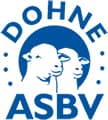Wool and carcase traits work for Clarkes
Article courtesy of ACM (Kylie Nicholls) The Land, Stock & Land, Stock Journal, Farm Weekly

Callum Clarke and his dog Ben, Karinella Farm, Goomalling, with some of their older Dohne ewes and first-cross lambs. The Clarkes have been breeding Dohnes for the past 10 years with excellent results.
THE dual-purpose attributes of the Dohne breed have given Western Australian mixed farmers, the Clarke family, a significant boost in the productivity in its sheep operation.
Based at Goomalling, fourth-generation farmer Ian Clarke and his son Callum currently run a self-replacing Dohne flock of 1600 ewes on their property, Karinella Farm, alongside a 1600 hectare cropping program, comprising wheat, barley and lupins which are sown in a companion system with tillage radish.
The Clarke family has always had sheep, originally running Merinos, then making a change to Dorpers.
They introduced Dohnes about 10 years ago, attracted to their mix of wool and carcase traits.
“Initially we were buying in lines of Dohne ewes and joining them to our Dorper rams and that gave good, fastgrowing prime lamb which were easy to sell and we found the ewes to be very easycare,” Mr Clarke said.
“But as time went on, buying in the Dohne ewes became more expensive and we decided to start breeding our own replacements.
“This also meant we could focus on using better quality genetics to improve the performance of our flock.”
They have been sourcing their Dohne rams from the Applegate family’s Mollerin Rock Dohne stud, Cadoux, with Mr Clarke’s partner Jenny-Lee responsible for selecting their sires.
“We use a mix of visual appraisal and Australian Sheep Breeding Values to select our rams, looking at their structure, particularly feet and legs, and carcase shape and length,” Mr Clarke said.
“Although we are more focused on the Dohnes as a meat sheep, their wool quality is till important and we aim to keep our flock at an average of 18 to 19-micron.
“As far as their figures go, we look at their growth rates, particularly post weaning weight, and carcase traits including eye muscle area.
“We’re really happy with the quality and evenness of rams from Mollerin Rock.”
The Clarkes have been joining their ewes to lamb from early May onward, plan to move this back by two weeks to start lambing from late May to fit in better with their cropping program.
Some of the older age group of Dohne ewes are still joined to Dorper rams to produce first-cross lambs.
“We’re finding when we go to sell the lamb that the pure Dohne lamb are selling just as well as the first-cross lambs,” Mr Clarke said.
“The Dohnes fast growth and carcase quality attribute arc really coming through which is very pleasing.”
Although the Clarkes haven’t been pregnancy scanning, they plan to start scanning for multiples to help fine-tune the management of their ewe and lift conception and lamb survival rates.
Current lamb marking rates average between 85 to 95 per cent.
ln recent years, the family has become involved in a carbon project through AgriProvc, sowing a range of multi-specie pastures which now play an important role in finishing their lambs.
The pastures comprise a diverse mix of species including tillage radish, serradella, oats, barley and chicory.
Lick feeders will also be available through the winter, supplementing the ewes with grain if required.
The lambs are weaned in October and moved onto the high perfonning pastures, before grazing lupin stubbles through the summer.
They are shorn in January or February, with the Clarkes aiming to sell the lambs through March and April at a target live weight of 45 kilograms plus, equating to a 21 to 22kg carcase weight.
Mr Clarke markets all the lambs over the hooks as he believes this provides the best indication of their performance, with the majority generally going to the V & V Walsh abattoir at Sunbury.
They have also sold them to the Tamrnin and ortham abattoirs and local butchers.
“We’ve had a good season this year, so we will probably sell some of the lambs as suckers,” he said
“The Dohnes have really added another dimension to our farming operation in the amount of sheep we can run, the ease of selling the lambs off and they are returning good money.
“What gives the Dohne its edge is their frame, they are big-bodied sheep, and all we have to do is fill that frame.”
About 200 Dohne ewe lambs are kept as replacements, selected on structure, weight, and wool quality.










 Facebook
Facebook YouTube
YouTube Instagram
Instagram